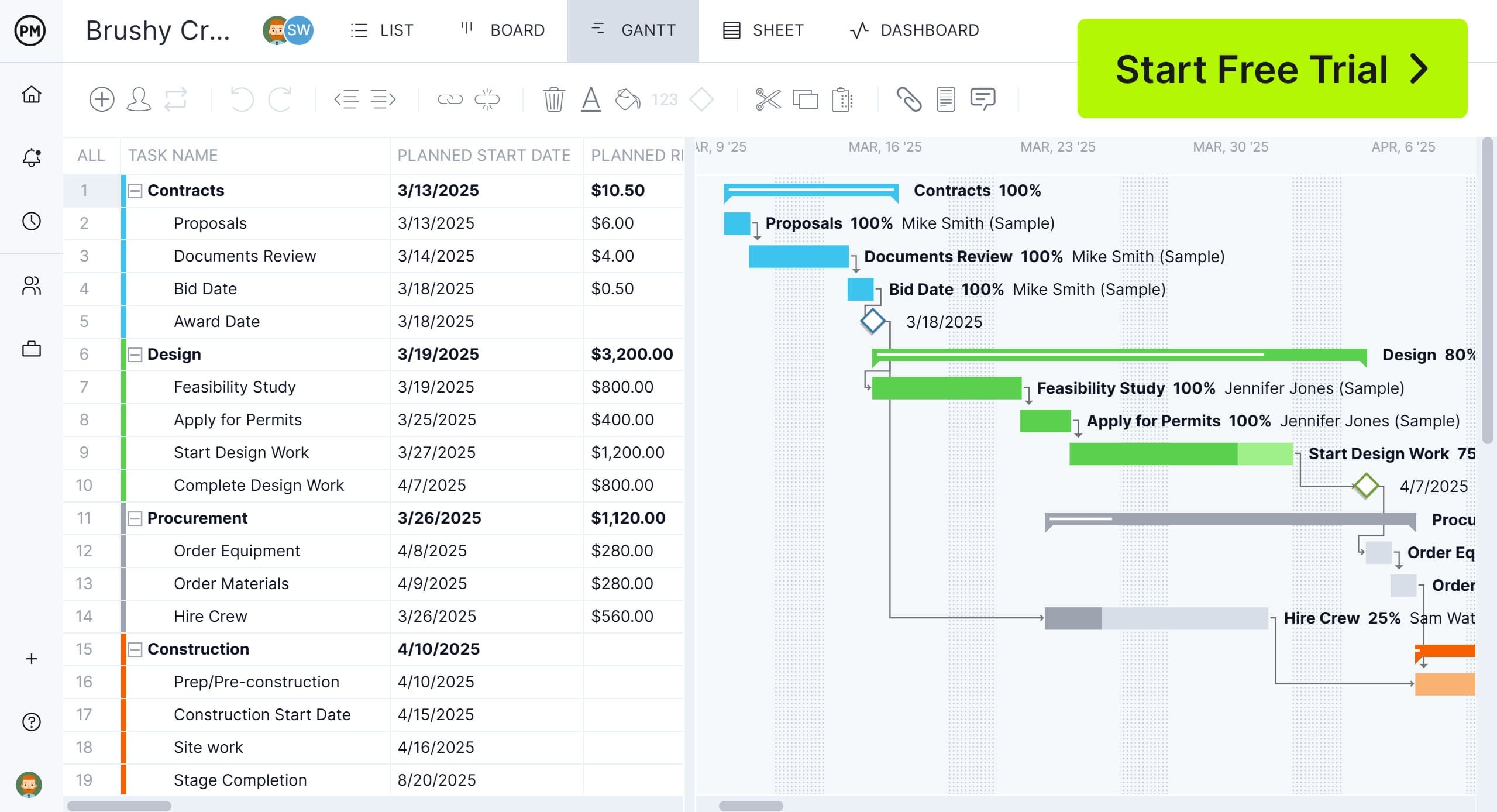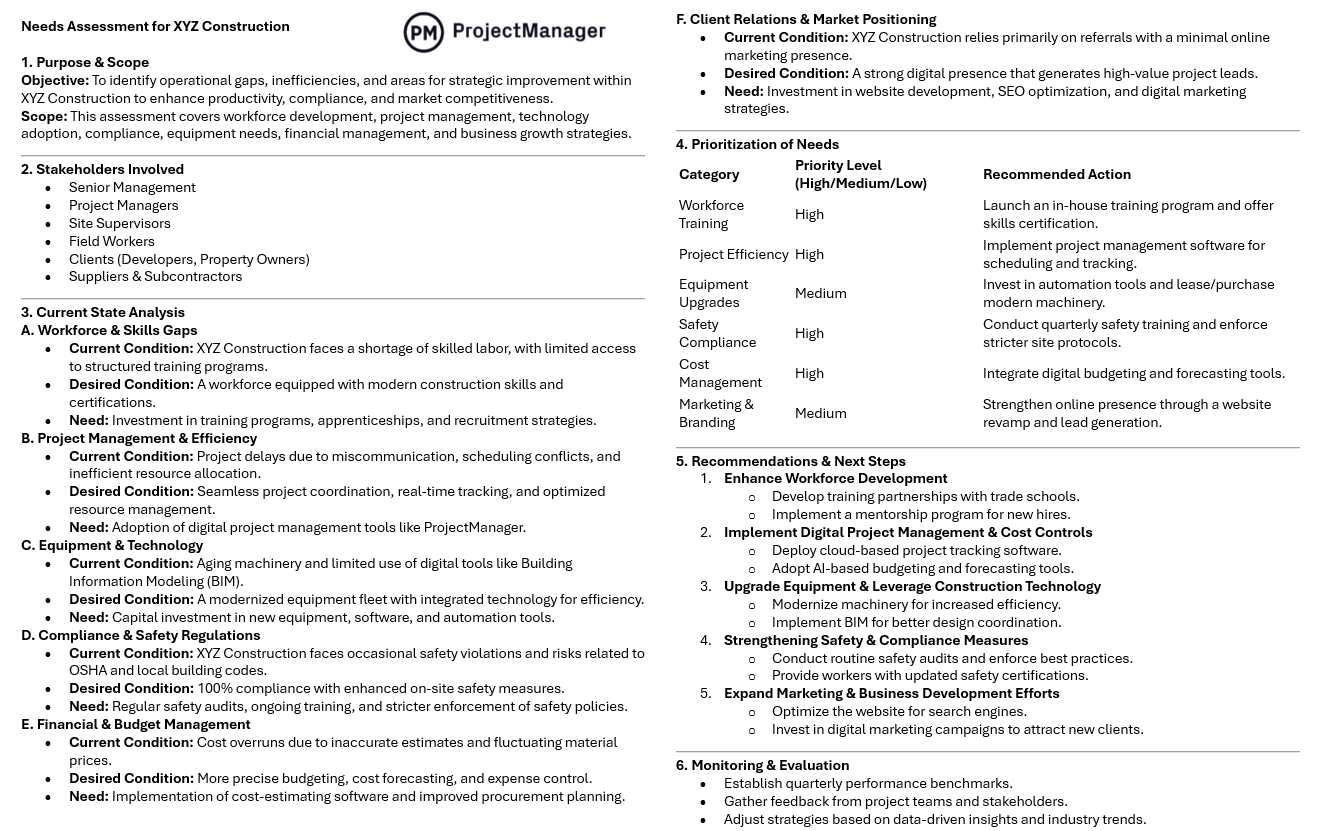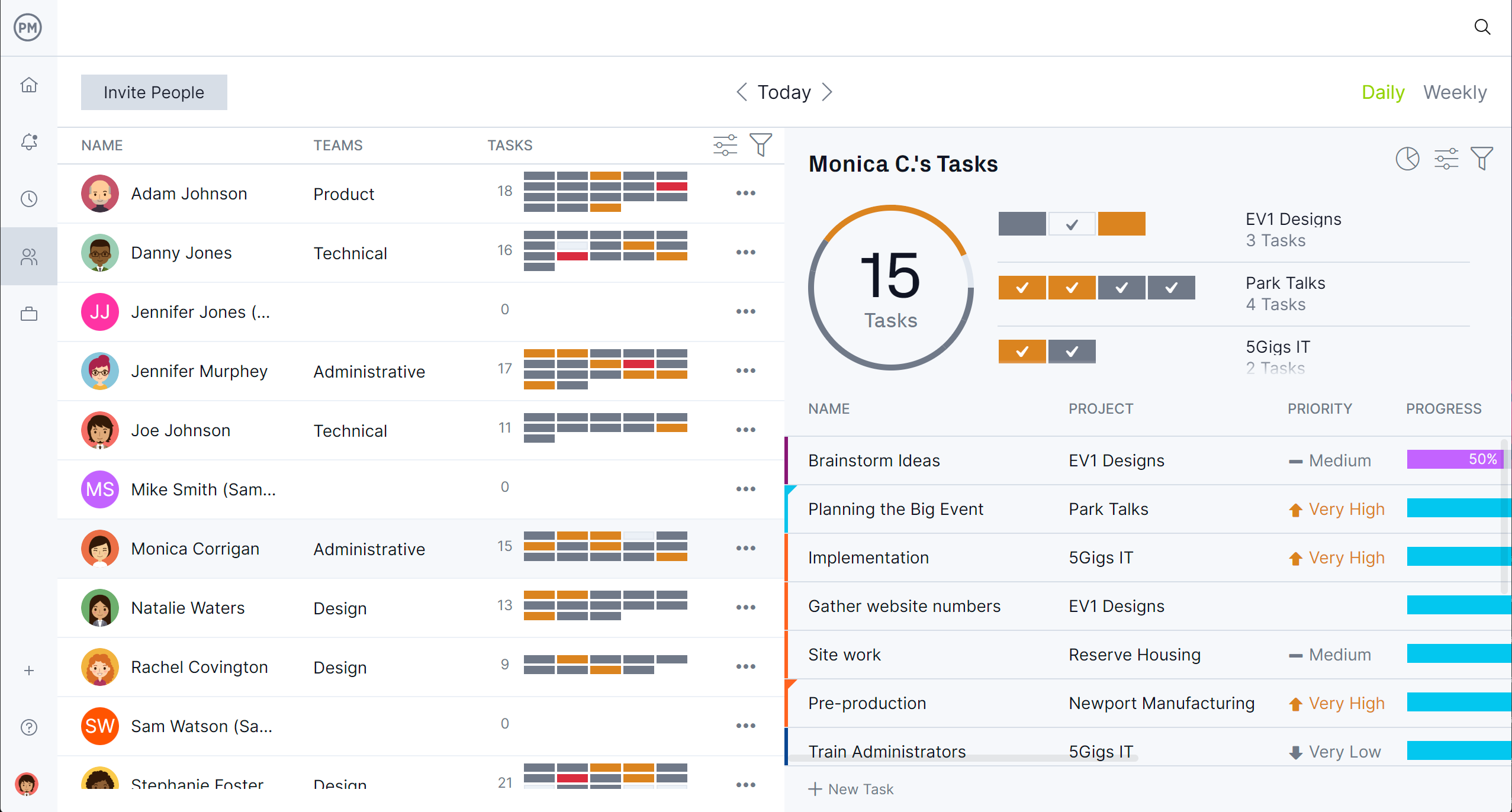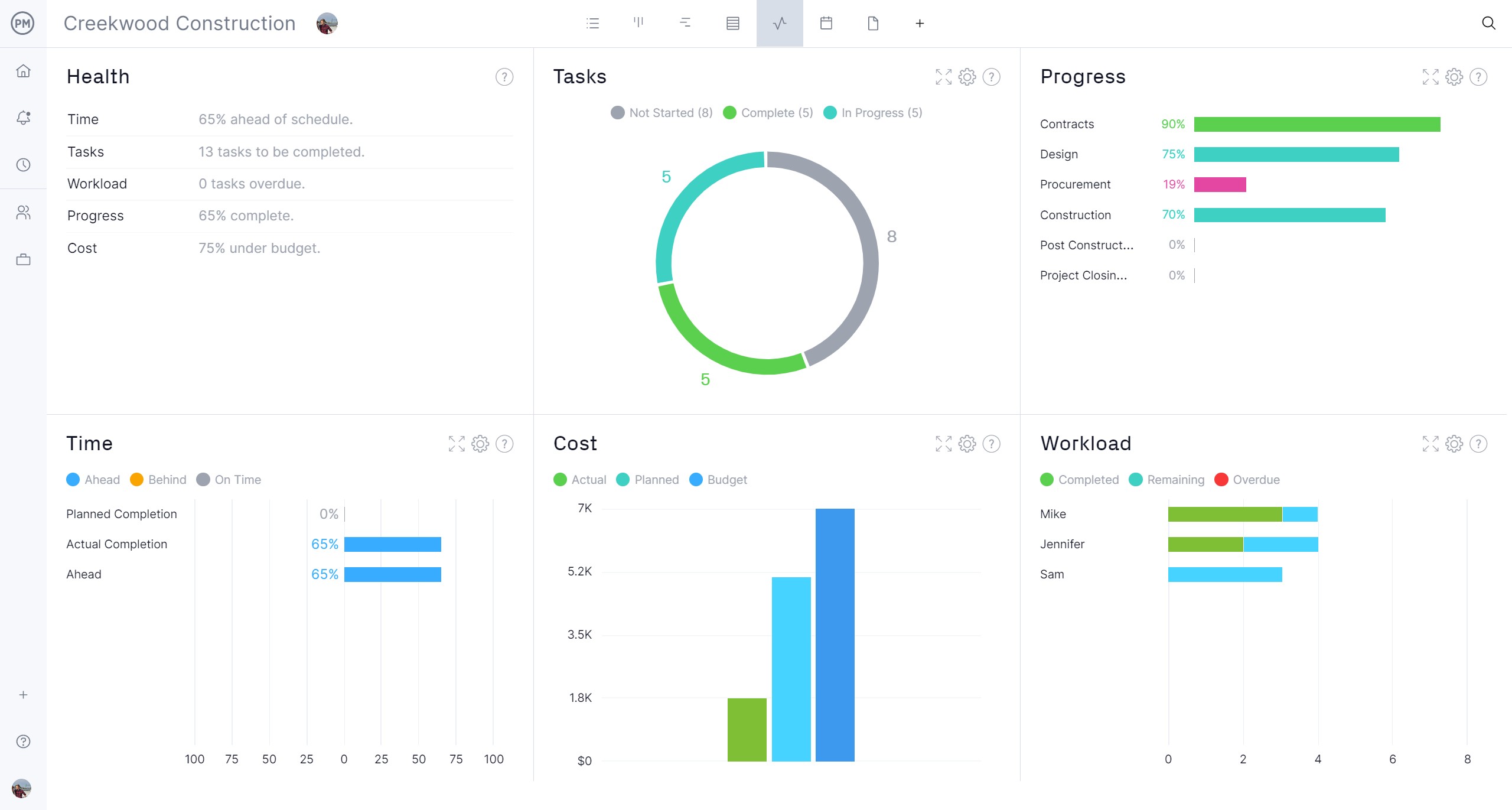Goals are set easily enough, but reaching them takes work. Sometimes that work is falling short, and project teams need to figure out why and how to get back on pace to meet their goals. For that, they use something called a needs assessment.
But what is a needs assessment, often called a needs analysis? We’ll answer that first before going into when one should take place and how to do it. To better understand, we’ll share an example and even a template to help readers get started.
What Is a Needs Assessment?
A needs assessment is a systematic process to identify and evaluate gaps between a current situation and desired outcomes. It helps organizations, teams or individuals determine what resources, skills or improvements are necessary to achieve their goals. By understanding what is lacking or what areas need enhancement, decision-makers can prioritize actions and allocate resources effectively.
Needs analysis can highlight areas where performance, knowledge or resources are insignificant. It can also help organizations focus on the most critical needs to maximize impact and provide data-driven insights to guide planning, budgeting and resource allocation. This improves efficiency by ensuring that time and resources are used on initiatives that directly address actual needs.
Once the needs assessment identifies gaps, priorities and the necessary resources, project managers can translate those findings into actionable tasks and milestones. This can be visualized on a Gantt chart, which is often a feature in project management software, to build an accurate and effective project timeline.
ProjectManager is award-winning project and portfolio management software with robust Gantt charts that turn needs assessments into scheduled tasks, resources and costs. Our Gantt chart goes further by linking all four types of task dependencies to avoid cost overruns. It also filters for the critical path and can set a baseline to track progress in real time. Multiple project views give teams the tools they need to execute their work, such as kanban boards and task lists, while stakeholders can monitor progress on the calendar view. Get started with ProjectManager today for free.

When to Conduct a Needs Assessment
Conducting a needs assessment at the right time ensures that resources are used efficiently and decisions are based on accurate information. Whether planning a new initiative, improving existing processes or addressing challenges, knowing when to perform a needs assessment can make all the difference.
A needs assessment is typically conducted at critical decision points, such as the start of a project, during periods of organizational change or when performance issues arise. By assessing the current state and comparing it to desired outcomes, organizations can develop targeted strategies and avoid unnecessary spending or misaligned efforts. Here are some examples of when it’s opportune.
- Business Strategy & Market Research: To identify gaps in products, services or market demand before making strategic decisions.
- Project Management: To define project requirements and ensure alignment with stakeholder expectations.
- Training & Workforce Development: To determine skill gaps and design employee training programs.
- Healthcare & Public Services: To assess community needs for healthcare, education or social services.
- Education & Curriculum Design: To align courses with student learning needs and industry requirements.
- Technology & System Implementation: To evaluate user needs before deploying new software, tools or infrastructure.
- Process Improvement & Quality Management: To identify inefficiencies and areas for optimization.
- Grant Writing & Policy Development: To justify funding requests and design effective policies based on community or organizational needs.
How to Conduct a Needs Assessment
Conducting a needs assessment is a structured process that follows a systematic approach, where teams can gather relevant data, engage key stakeholders and develop actionable solutions. Each step in the process builds upon the previous one, ensuring that the final recommendations are well-informed and aligned with organizational goals. To do one, follow these seven steps.
1. Establish the Purpose and Scope of the Needs Assessment
Begin by defining the reason for the assessment and what you hope to achieve. Clarify the specific problems or opportunities you are addressing, and determine the boundaries of the assessment. A clear purpose and scope ensure that efforts remain focused and actionable.
2. Identify Key Stakeholders
Engage the individuals or groups directly or indirectly affected by the assessment’s findings. This may include employees, managers, customers or community members. Involving stakeholders early ensures diverse perspectives are considered and increases buy-in for the proposed solutions.
3. Collect Data
Gather relevant information through surveys, interviews, focus groups, observations or reviewing existing data. Use both qualitative and quantitative data to get a comprehensive view of the current situation. Reliable data serves as the foundation for identifying and understanding gaps.
4. Define the Gap Between Current and Desired State
Analyze the data to compare the existing conditions to the ideal outcomes. This step helps identify where shortfalls exist and what is preventing the organization from reaching its goals. Visual tools like charts and graphs can make gaps more apparent.
5. Identify Deficiencies and Needs to Close the Gap
Determine the specific issues that must be addressed to bridge the gap. This could include a lack of resources, insufficient training, inefficient processes or missing infrastructure. Prioritize needs based on their impact and feasibility.
6. Develop an Action Plan
Create a detailed plan outlining how to address the identified needs. Define actionable steps, assign responsibilities, set timelines and allocate resources. A well-structured action plan provides a clear roadmap for implementation.
7. Monitor and Report on Progress
Once the action plan is underway, establish a system to track progress and measure outcomes. Regular reporting and feedback from stakeholders help ensure the plan remains effective. Adjustments can be made as needed to keep efforts on track and aligned with goals.
Needs Assessment Example
This is very abstract, of course. For many, the concept and process become clearer when illustrated in a real-life example. Let’s look at how a needs analysis works in an industry like construction.

The above example shows the various stakeholders and the current state of the business. It also defines its client relations and marketing positioning. This leads to the prioritization of needs, recommendations and next steps. There’s also a section to monitor and evaluate the actions taken.
Needs Assessment Template
Download this free needs assessment template to guide the process of identifying and evaluating gaps between the current state and desired outcomes. It provides a clear framework for collecting data, analyzing findings and developing actionable recommendations.

Organizations can use this free template to ensure a consistent and thorough approach to their needs assessment. It streamlines the process, promotes consistency across projects and makes sure that all relevant factors are considered when making decisions.
Benefits of Conducting a Needs Assessment
To reiterate, a needs assessment is a valuable tool that helps organizations achieve their goals by creating targeted solutions that drive meaningful improvements. Whether used in project planning, organizational development or community initiatives, a needs assessment helps ensure efforts are aligned with actual needs. Here’s a list of those advantages.
- Informed Decision-Making: Provides data-driven insights to guide strategic planning and resource allocation.
- Efficient Resource Use: Ensures time, budget and personnel are focused on the most critical needs.
- Improved Problem Solving: Identifies root causes of challenges, leading to more effective solutions.
- Enhanced Stakeholder Engagement: Involves relevant stakeholders, fostering collaboration and support.
- Measurable Results: Establishes clear benchmarks for tracking progress and evaluating success.
- Reduced Risk: Minimizes the likelihood of project failure by addressing potential issues early.
- Increased Accountability: Creates transparency and clarity on objectives, responsibilities and timelines.
How to Manage Needs Assessment Projects With ProjectManager
Managing the needs analysis and the project that comes from that process requires more than a template. Templates are fine in their place, but these static documents are not equipped to deal with the dynamic nature of managing projects. Project management software has the tools to plan, manage and track that work. ProjectManager is award-winning project and portfolio management software that streamlines planning, data collection, analysis and reporting. It allows teams to collaborate, tracks progress and makes sure that actionable insights are turned into successful outcomes.
Allocate Resources Effectively
To ensure that each phase of the assessment is completed without delays or resource constraints, start by scheduling them on the Gantt chart. Then, when onboarding the team, set their availability to streamline assignments. For an overview of resource allocation, go to the workload chart. It’s color-coded, which makes it easier to see who is overallocated or underutilized.
Project managers can balance their team’s workload from the chart to keep everyone working at capacity without worrying about burnout. There’s also a team page that provides a daily or weekly summary of team activity. It can be filtered by priority or progress, and tasks can be updated right from that page.

Track Progress With Real-Time Dashboards and Reports
For the monitoring and evaluation phase of the needs assessment, several tools can help keep the project on track. For a high-level overview, toggle to the real-time project or portfolio dashboards. They show metrics, such as time, cost, workload and more, on easy-to-read graphs and charts.
Customizable reports on status, variance, timesheets, workload and more show progress, other findings and provide actionable insights. They can also be shared with stakeholders to keep them updated. Even our secure timesheets help keep projects on budget by monitoring labor costs.

Related Needs Assessment Content
There are other ways to find gaps in one’s current status and desired future state outside of a needs analysis. For those interested in reading more about gap analysis, root cause and more, below are some recent posts from our blog.
- How to Conduct a Gap Analysis: Definition, Steps & Example
- Gap Analysis Template for Excel (Free Download)
- How to Write an Action Plan (Example Included)
- Root Cause Analysis: A Quick Guide
- 5 Whys Technique in Root Cause Analysis
ProjectManager is online project and portfolio management software that connects teams whether they’re in the office or out in the field. They can share files, comment at the task level and stay up to date with email and in-app notifications. Join teams at Avis, Nestle and Siemens who use our software to deliver successful projects. Get started with ProjectManager today for free.



